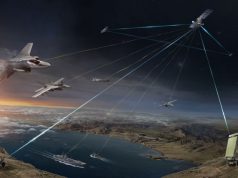The US Army successfully engaged a cruise missile target during the eighth and final developmental flight test of its Integrated Air and Missile Defense Battle Command System (IBCS).
The IBCS managed to guide an intercept of the missile in a highly contested electronic attack environment during a test at White Sands Missile Range in New Mexico.
Without revealing when exactly the test took place, Northrop Grumman said the IBCS demonstrated integration with the US Marine Corps AN/TPS-80 Ground/Air Task-Oriented Radar (G/ATOR) system.
The flight test also incorporated first-time live testing and demonstration of a Joint Track Manager Capability (JTMC) which provided a bridge between IBCS and the Navy’s Cooperative Engagement Capability (CEC), enabling the sharing of G/ATOR track data on the IBCS Integrated Fire Control Network (IFCN).
With support from Lockheed Martin, the flight test architecture also incorporated two F-35 combat aircraft integrated on the IFCN with on board sensors contributing to the IBCS developed joint composite track used to perform the engagement.
“The integration of additional sensors from multiple services continues to show the power inherent in the IBCS architecture and design to incorporate and integrate joint sensors across multiple domains,” said Christine Harbison, vice president and general manager, combat systems and mission readiness, Northrop Grumman. “By enabling joint operation and utilizing multiple sensors operating in various bands, IBCS was able to operate through the electronic attack environment so soldiers can identify, track and ultimately intercept the threat.”
IBCS is designed to provide the Army with an integrated command-and-control system, capable of blending current and future air and missile defense sensors and weapon systems under a unified network. IBCS enables battle survivable “any-sensor, best-effector” operations by fusing information from multiple, disparate sensors to create a single integrated air picture, and employing all available effectors to defeat advancing threats.
Two surrogate cruise missiles were launched in the test, one performing the electronic attack mission to disrupt radar performance, and the other flying a threat profile targeting friendly assets. Soldiers of the 3-6 Air and Missile Defense Test Detachment used IBCS to track the surrogate cruise missile targets, identify the threatening missile, and launch a Patriot Advanced Capability Three (PAC-3) interceptor.
The latest flight test integrated the widest variety of sensors to date on the IFCN for an IBCS test, including one Marine Corps G/ATOR, two Army Sentinel radars, one Army Patriot radar and two US Air Force F-35 fighter aircraft.
The Gallium Nitride-based AN/TPS-80 G/ATOR is a digital, software-defined advanced Active Electronically Scanned Array (AESA) multi-mission radar that provides comprehensive real time, full-sector, 360-degree situational tracking against a broad array of threats.
This was the eighth of eight developmental or operational flight tests performed with the IBCS program. The test was conducted as risk reduction prior to beginning the Initial Operational Test & Evaluation (IOT&E) phase this fall.
IOT&E is a comprehensive test of IBCS system performance which will be conducted under realistic operational conditions prior to system employment. The IOT&E informs a Department of Defense and US Army initial operational capability decision.



























